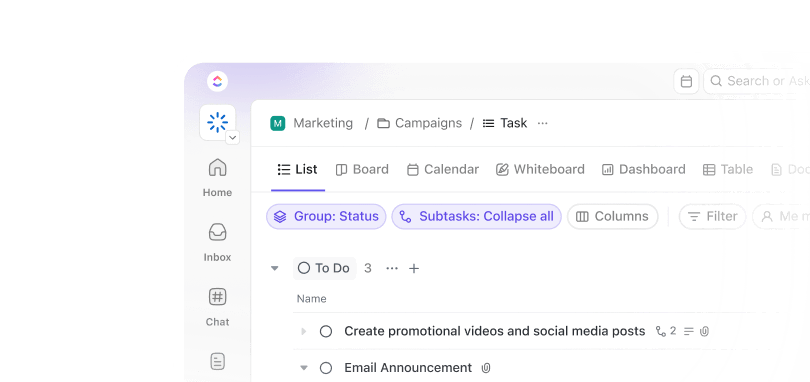Client referrals are a signal that you’re doing something right.
When a happy client recommends your services to a friend, colleague, or even someone on the internet, it builds trust instantly. No long sales pitch. No cold outreach. Just a warm lead that’s ready to work with you.
But here’s the thing: getting consistent referrals doesn’t happen by accident. You need a clear referral strategy, the right tools to track referrals, and a system that makes giving and receiving referrals seamless — for both you and your clients.
In this blog, we’ll walk you through how to create a successful referral process, from understanding what makes referrals powerful to setting up an automated client referral program. You’ll also get templates, tips, and tools to make it all click.
Let’s start by understanding the real power behind referrals.
⏰ 60-Second Summary
Short on time? Here’s a quick breakdown of what you’ll learn:
- A good referral program page can help you promote and track everything, while making it easier to generate new referrals with minimal effort
- Client referrals happen when your current or past clients recommend you to prospective clients, often leading to more referrals and better-quality leads
- They’re powerful because they shorten your sales cycle, cost less than ads, and bring in loyal customers who already trust you
- To set up a client referral program, you need to: Identify who’s likely to refer you, offer simple and meaningful incentives, make the process super easy for clients to follow
- Use Forms, Automations, and CRM to streamline your referral process and manage it all in one place
Understanding Client Referrals
A client referral is when someone — typically an existing client or a happy customer — recommends your services to someone in their network. It could be a coworker, a friend, or even a family member. The referred person becomes a new client, often faster than a cold lead, because trust’s already involved.
In a world of ads, emails, and endless social media noise, referrals are like gold. They cut through the clutter because they come from real people with real experiences.
📌 Example: Let’s say you’re a freelance designer. One of your clients shares your work with a business friend. That friend reaches out, already interested. You’ve now skipped the “prove yourself” phase and landed a potential customer with ease.
This works for:
- Independent contractors looking to expand their client base
- Agencies that want high-converting leads
- Service-based professionals who thrive on trust and reputation
- Even tech companies that want to build long-term partnerships
So, if you’re not actively encouraging or tracking referrals, you’re leaving revenue on the table.
💬 Did You Know? When a consumer is recommended a product or service by someone they know, they are almost 2x more likely to take action.
Benefits of Client Referrals
You might wonder why you should put so much effort into a referral strategy when you could just run an ad. Because referrals offer benefits that no paid channel can:
✅ Convert better
Referred clients convert 4x faster. Why? Because they already trust you — thanks to the person who recommended you.
✅ Reduce costs
With referrals, there’s no spending money on ad budgets or cold outreach tools. It’s pure organic growth, powered by positive feedback and reputation.
✅ Bring in better clients
People who come through referrals often stick around longer, spend more, and are more likely to refer others. Talk about a flywheel effect!
✅ Shorten sales cycles
Referrals already know what you offer. That means fewer meetings, less convincing, and a quicker “yes.”
✅ Boost credibility
A list of loyal customers who actively recommend you adds massive social proof to your brand.
📚 Read More: Want to build customer loyalty into your entire customer journey? Don’t miss our blog on client retention strategies for more ideas.
Creating a Client Referral Program
So, how do you move from the occasional “Hey, I told someone about you” to a consistent stream of high-quality leads?
You need a referral program that’s not only easy to join but also rewarding and aligned with your client’s experience. Here’s how to build a referral engine that runs on autopilot but feels personal.
1. Define your ideal referrer
Not every client will send you more clients—and that’s okay. The trick is to focus on happy, loyal customers who’ve had a positive experience and genuinely believe in your services.
📌 Example: If you’re a branding consultant, your ideal referrers might be small business owners whose launches you’ve helped succeed. They’ve seen real value and will be more inclined to recommend you to others in their network.
💡 Pro Tip: Go through your reviews and testimonials. Notice who’s been most vocal about your work—that’s where your referrals can begin. Tools like CRM help you tag and track these relationships for future outreach.
2. Choose a referral incentive
Let’s face it—people are more likely to spread the word when there’s a little something in it for them. But that “something” doesn’t always have to be money.
🎁 Reward ideas based on your business type:
- Freelancers: Offer discounts on next month’s retainer, an extra deliverable at no cost, or even a free strategy call
- Agencies: Credits toward future services, early access to a new offering, or an upgrade
- Independent contractors: A flat fee or gift cards for every qualified lead they refer
- B2B service providers: Donations to a charity of their choice, team shout-outs, or a formal rewards program
📝 Include a unique referral link or referral code in your emails or thank-you messages. With , you can track these codes using custom fields to monitor who’s referring whom and how successful those leads are.
💬 Did You Know? Dropbox grew its user base by over 3900% using a referral strategy that rewarded both the referrer and the new user with storage space. Small rewards can lead to massive growth.
3. Create a simple process
This is where most referral programs fail—too many steps or confusing forms can turn even your happiest customers away.
🔧 Keep the referral process lean and intuitive:
- Share pre-written messages your clients can copy and send to friends or colleagues
- Include a referral form on your website using Forms. Clients fill it out in seconds, and you capture the lead without back-and-forth emails
- Link to a dedicated referral program page that explains the benefits, rules, and rewards clearly
📌 Example: A wedding photographer can add a line to their email like:
“Know someone getting married soon? Refer them and get a free mini shoot! Fill out this quick form 👉 [YourFormLink].”
💡 Pro Tip: Add a CTA to your client portal or invoice that reads: “Love working with us? Share the love and earn rewards—click here to refer someone!”
4. Promote your program
Once your referral program is ready, you can’t just let it sit quietly. You have to promote it consistently—but subtly.
📍 Where to mention your referral program:
- In your email signature
“P.S. We reward referrals! Know someone who needs [service]? Refer them here.” - At the end of thank-you emails or project completion notes
- On your invoices or proposal documents
(Tip: Add a short line like “Get $100 off your next project by sending us a client!”) - On your website footer, dashboard, or ‘Work With Us’ page
📱 You can also create a series of posts on social media explaining how your referral program works—include client shout-outs, stories of successful referrals, or rewards unboxed.
📮 Insight: 32% of workers occasionally work beyond their scheduled hours, while 24% put in extra hours most days. The problem? Without boundaries, overtime becomes the norm instead of the exception.
Sometimes, you need a little help setting those boundaries. Ask Brain, ’s built-in AI assistant, to step in and create an optimized schedule for you. Built directly into your workspace, it shows which tasks are actually urgent and which ones are not!
💫 Real Results: Lulu Press saves 1 hour per day, per employee using Automations—leading to a 12% increase in work efficiency.
5. Track and measure your referrals
You can’t improve what you don’t track. Once your referral program is live, set up a system to:
- Monitor who referred whom
- Track the status of each referred lead (did they convert, ghost, or become loyal clients?)
- Analyze which referral source brings the best ROI
- Attribute rewards correctly
💡 Pro Tip: Use Dashboards to create a referral tracker that shows how many referrals you’ve received this month, who your top referrer is, and which incentive is performing best.
6. Say thank you — and mean it
Sounds simple, but this is the most overlooked part of a client referral strategy.
A personalized thank-you message (via email, a handwritten note, or even a quick video) adds warmth to your brand. It strengthens your relationship with the referrer, making more referrals likely in the future.
📌 Example: “Hey Sarah, I just wanted to say a big THANK YOU for sending Josh our way. We loved working with him! Here’s a little gift to show our appreciation.”
💡 Pro Tip: Set up a Automation that triggers a thank-you email every time a referral is marked as “Client Won.” 🎉
Strategies to Obtain Client Referrals
A strong referral strategy isn’t about luck. It’s about consistently showing up, delivering value, and gently reminding people that you welcome referrals.
Here are some effective strategies to get the ball rolling:
1. Deliver a memorable experience
This comes first, always. People give positive feedback only when they feel wowed. Focus on being reliable, proactive, and friendly — this lays the foundation for receiving referrals naturally.
📌 Example: Let’s say you run a digital marketing agency. You overdeliver by giving bonus strategy insights during a call. The client’s impressed — and later introduces you to two potential customers.
2. Ask at the right time
When’s the best time to ask for referrals? Right after a win. Maybe your client just hit a revenue goal thanks to your help, or they’re excited after launch day. That’s the golden moment to ask:
“Know someone who could use results like this? I’d love an intro!”
3. Make it super easy
No one wants to fill a 10-step form. The fewer clicks, the better. Create a clear process using a Form and share a short referral link or a ready-to-forward message.
4. Use social media to nudge referrals
Sometimes, a quick reminder on LinkedIn, Twitter, or even Instagram can remind existing customers that they can refer others.
📌 Example: Add a CTA like:
💬 “Loved working together? Know someone who needs help with [your service]? Send them my way!”
Managing Referrals Efficiently with
Once you start getting referrals, tracking and managing referrals can become overwhelming without the right tools.
, the everything app for work, offers a comprehensive solution to streamline your referral process, from tracking sources to automating follow-ups and collaborating with clients.
With CRM, keeping track of referrals is a breeze. You can see where they’re coming from, follow up fast, and stay organized. By leveraging ’s features like Custom Fields, Automations, and Forms, you can create a seamless and efficient referral management strategy for better results with less effort.
Here’s how:
1. Track referral sources
Custom Fields allow you to monitor where referrals originate. You can create fields to categorize referrals by source, such as social media, email campaigns, or word-of-mouth. This helps you analyze which channels are most effective and optimize your referral strategies.


- Create a custom field for “Referred By”
- View all new referrals in one list or dashboard
- Segment by referral link or referral code
- Use tags like “warm lead” or “repeat referrer”
No more digging through emails to find who sent whom.
You can visualize referral data using Dashboards. Add widgets to track the number of referrals from each source, helping you identify the most effective channels.
➕ Bonus: You can even create a view for your referral program page leads and assign tasks to follow up within one business day.
2. Automate follow-ups
Set up Automations so you don’t have to manually track every referral or send reminders, and save time by automating repetitive tasks.
📌 Example:
- Set up an automation to send a follow-up comment or notification to a team member when a referral task is created
- Automatically change task statuses (e.g., from “New Referral” to “Contacted”) based on specific triggers like a custom field update
It’s perfect for small teams, agencies, or tech companies juggling multiple moving pieces.
3. Collect referrals using Forms
Want a simple way to collect referrals? Use a Form — either embedded on your website or shared via link.


’s Forms can be customized to capture all necessary details, and submissions can automatically create tasks in for easy tracking and management.
Forms can include fields for:
- Referrer’s name and contact details
- Referred client’s name and requirements
- Additional notes or preferences
Use conditional logic in forms to create dynamic fields that adapt based on user input.
📌 Example: If the referrer selects “Existing Client,” additional fields can appear to gather more details.
Embed these forms on your website or share them via a link to make it easy for clients to submit referrals. Every submission becomes a task you can assign, nurture, and track to closure — with minimal effort.
Best Practices for a Sustainable Referral Program
Getting a few referrals is great, but building a referral system that keeps running without burning out your team or budget? That’s the dream.
Here’s how to keep your referral program sustainable and scalable:
1. Keep your referral process transparent
Make it super clear what people need to do and what they’ll get. Whether it’s a cash reward, credits, or a shoutout, clarity encourages more people to participate.
Set expectations right on your referral program page. Mention:
- Who can refer
- What counts as a successful referral
- How long it takes to receive rewards
- How you’ll track referrals
2. Don’t overcomplicate the reward structure
If your rewards program has too many tiers or terms, people will just skip it. Stick to one or two simple outcomes — like “$50 for every new customer who signs up” or “10% off for each successful intro.”
And remember, rewards don’t always have to be monetary. Surprise gifts, exclusive content, or even a personal thank-you video can do the trick — especially for loyal customers.
3. Use automation to follow through
Many referral strategies fizzle out because no one follows up. With Automations, you can:
- Trigger thank-you tasks when someone refers a lead
- Alert your sales team when a prospective client signs up
- Move referred leads into a “Referral Pipeline” for quick action
This way, you’re not spending money or time chasing updates — and no referrer feels forgotten.
4. Make it easy to promote
The easier it is for clients to share your info, the more new referrals you’ll get. Offer ready-to-use templates, shareable referral links, or even QR codes they can send to family members, friends, or peers. Keep these links short and memorable:
📌 Example: yoursite.com/refer
5. Keep your client base in the loop
A client referral program isn’t “set it and forget it.” Remind your existing clients about it every so often — in newsletters, invoices, even casual emails.
You could say: “Hey, we’re growing — and would love your help. Know someone who needs [your service]? If they sign up, you both get a reward.”
It’s a gentle ask, but one that sparks more referrals when timed right.
💬 Did You Know? According to Nielsen, 92% of people trust referrals from people they know over any other form of advertising.
Client Referral Program Examples
Let’s look at a few client referral program example setups depending on your business type:
🔹 Freelancer
- Reward: 10% off the next project
- Method: Referral email template + Form
- Promotion: Pinned post on social media
🔹 Marketing agency
- Reward: $100 Amazon gift card for a closed client
- Method: Branded referral program page with form
- Promotion: Added to all client email footers
🔹 Tech company
- Reward: $50 per signup, plus $200 bonus after 5 referrals
- Method: Unique referral link per customer
- Promotion: Pop-up CTA in the dashboard
Make Referrals Work for You
Your best leads are already in your inbox — they just haven’t been introduced to you yet. A well-crafted client referral program is how you unlock them.
With the right process, messaging, and automation (hello, !), you can grow your client base, build credibility, and bring in new clients — without spending a fortune.
And the best part? It only takes one happy client to get the referral wheel spinning. Then another. And another.
And remember, rewards don’t always have to be monetary. Surprise gifts, exclusive content, or even a personal thank-you video can do the trick — especially for loyal customers.
Get started with for free now and create a winning client referral strategy.


Everything you need to stay organized and get work done.













